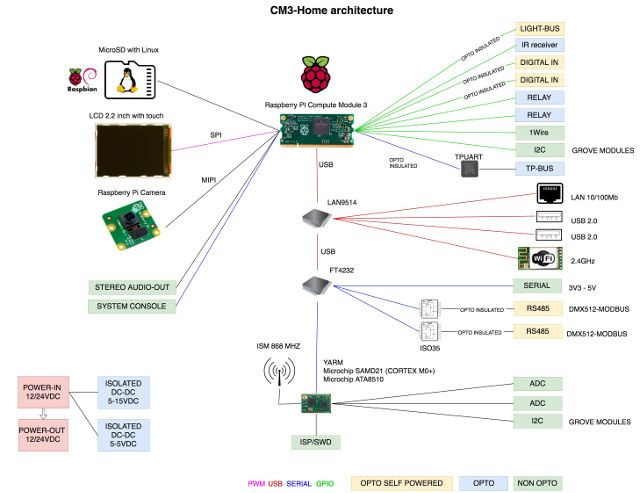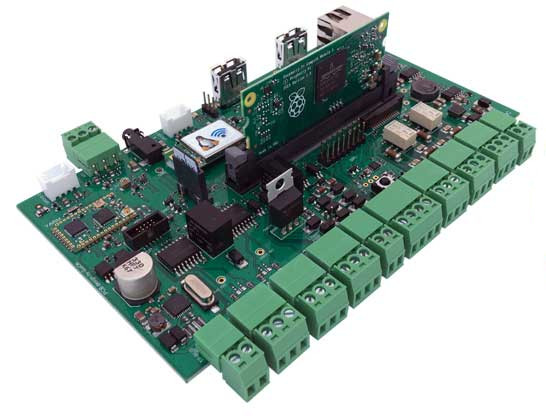Raspberry Pi CM3 & CM3L modules are used in so many devices it’s hard to keep up. From NEC digital signage displays, to industrial touch panels, and IoT gateways, the Broadcom BCM2837 based system-on-module are found in more and more products and solutions, and number of announcements seems to have increased over the last few months.
The latest product to leverage Raspberry Pi CM3L SoM is made by Italy based Acme Systems, and designed for home automation. CM3-HOME comes with opt0-isolated inputs compatible with KNX and DALI buses, various connectivity options (Ethernet, WiFi, Bluetooth, 868MHz ISM radio…), and other expansion port. Two edition of the boards are available: LITE and FULL, with the former suitable for most home automation project, and the latter adding support for some commercial lighting systems and energy harvesting Radio ISM nodes.
Acme CM3-Home specifications:
- 200-pin SODIMM Module Slot compatible with Raspberry Pi CM3 / CM3L modules (BCM2837 quad core Cortex A53 SoC / 1GB RAM, 4GB+ eMMC flash or micro SD card)
- Connectivity
- 1x 10/100M Ethernet port
- 802.11 b/g/n WiFi enabled for access point mode (optional on LITE edition)
- Yarm ISM radio module at 868 MHz with a Microchip SAMD21 ARM Cortex M0+ core fully available for customer application (FULL edition only)
- I/Os terminals / expansion header
- 2x opto-isolated RS485 (Only 1x not-isolated on LITE edition)
- 1x TTL level serial port for system console
- 1x TTL level serial port for external micro controller
- 1x 1-wire bus
- 2x Grove I2C headers (Only 1x Grove header on LITE version)
- 2x low power relays
- 2x opto-isolated dry contact inputs (2x not isolated on LITE version)
- 2x ADC inputs for resistor balance tampered sensors (FULL edition only)
- 1x opto-isolated twisted pair bus (TP-BUS) electrically compatible with KNX bus (via Siemens TP-UART-2 chip on FULL version only)
- 1x opto-isolated twisted pair bus electrically compatible with DALI bus (FULL Edition only)
- 1x SPI/GPIO port for small TFT LCD display modules (Optional on LITE edition)
- Audio – Stereo audio out
- Camera – 1x MIPI CSI connector for Raspberry Pi camera
- SB – 2x USB 2.0 host ports
- Misc – 1x IR remote receiver at 38KHz (Optional on LITE edition)
- Power Supply – 12 to 24V DC input
- Dimensions – TBD

Acme Systems will not provide ready-to-use micro SDs or support to install software on this board, so it’s made for system integrators or individuals who already know how to use the Raspberry Pi. However, the company has provided documentation to use OpenHAB & KNX, integrate the gateway with other devices like Sonoff TH16 wireless switch, IKEA Tradfri smart kit, SDM120 energy meter, etc…, on Tanzolab.it (in Italian only for now).
CM3-HOME board can also fit into 9-module DIN RAIL case made by ELBag. The board will be introduced at the Maker Faire Rome 2017 on December 1-3, 2017, and officially launch on December 5, with sample pricing starting at 130 Euros for the LITE edition, and 330 Euros for the FULL edition, not including CM3L module. Discounts are available for orders of 10 units or more. You may find additional details on the product page.
Thanks to Theguyuk for the tip

Jean-Luc started CNX Software in 2010 as a part-time endeavor, before quitting his job as a software engineering manager, and starting to write daily news, and reviews full time later in 2011.
Support CNX Software! Donate via cryptocurrencies, become a Patron on Patreon, or purchase goods on Amazon or Aliexpress





